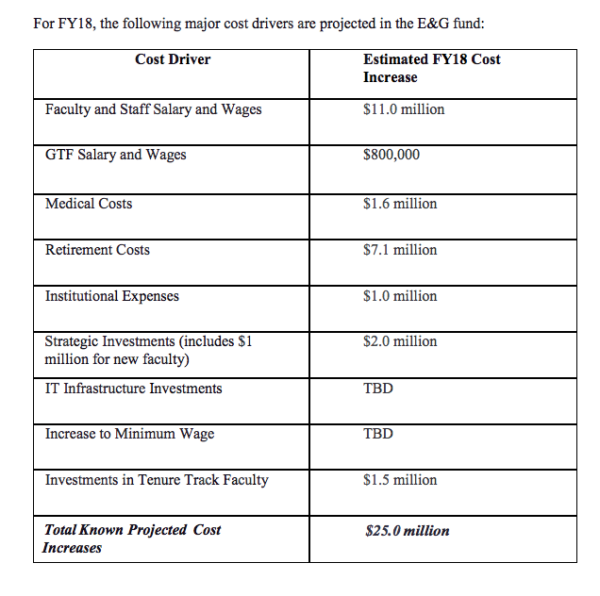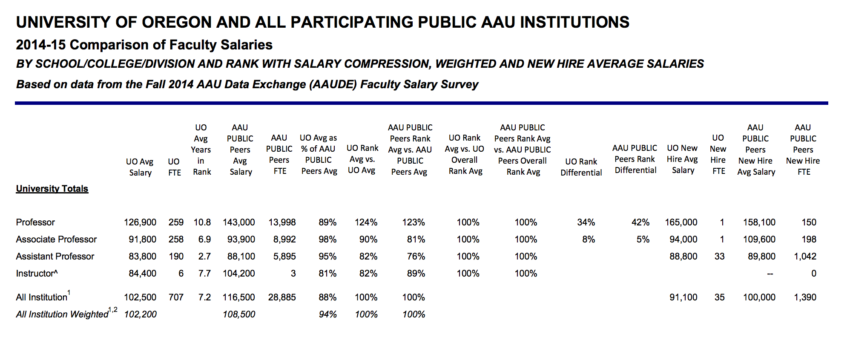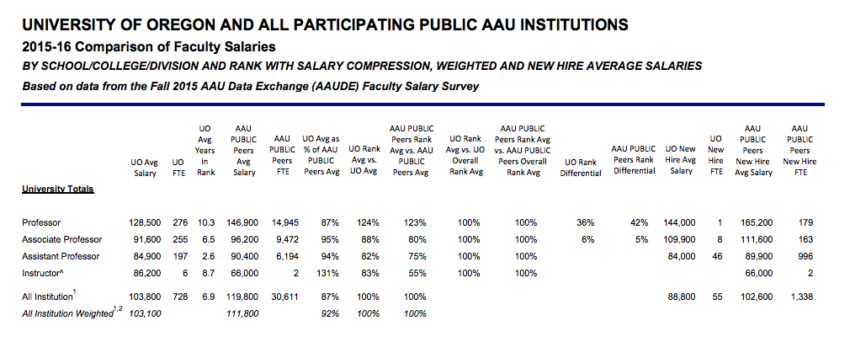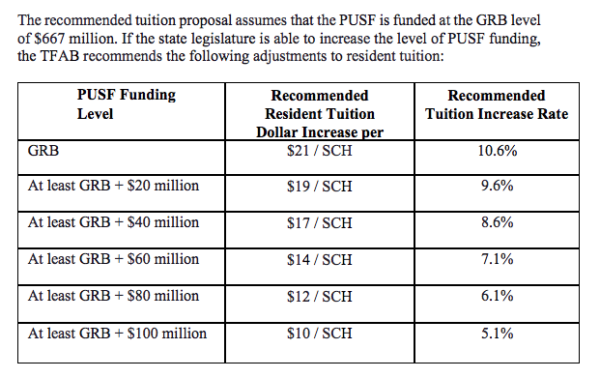An excerpt from Pres Schill’s letter:
As I have already noted, we will do everything we can to shield our most vulnerable
students from the impact of this proposed tuition increase. The PathwayOregon
program continues to provide full tuition and fees to about 2,000 Pell Grant–eligible
resident students on our campus, including more than a third of our first-year resident
students. [UOM: Thanks in part to the generosity of Trustee Connie Ballmer.]
We have also made significant progress toward achieving the goals set when
we announced the Oregon Commitment in 2015, which provides advising, planning,
and academic resources to help every student at the university graduate in a timely
fashion. To every extent possible, we intend to maintain the integrity of those important
efforts.
TFAB report here: http://ir.uoregon.edu/sites/ir.uoregon.edu/files/TFAB_Memo_2-9-17.pdf. They are reporting the following cost increases:

Despite that $11M salary increase – a good chunk of which goes to upper administrators – UO faculty pay is getting worse, relative to our comparators:


For 2015-16, UO Assistant profs averaged 94% of AAU public university salaries, Associates 95%, Fulls 87%. That’s down from 95%, 98%, and 89% the year before. So UO is not going to be able to maintain “excellence” without more money.
No differential tuition for B-School this year, and the in-state tuition increases will be bought down if the legislature coughs up more money:

Full text of the letter:
To University of Oregon community members,
Pursuant to university policy, the provost and I have received the recommendations of
the Tuition and Fee Advisory Board (TFAB), a body containing students,
administrators, and members of the faculty and staff. Among the recommendations is an
increase in tuition of $21 per credit hour—or $945 per year—for in-state undergraduate
students. The TFAB recommends the same increase for out-of-state undergraduates
students of $21 per credit hour, or $945 annually. For the 2017–18 academic year, this
equates to a 10.6 percent increase in undergraduate tuition for in-state students and a 3
percent increase for out-of-state students. The TFAB also recommended various tuition
increases for graduate tuition and a new technology fee of $50 per term.
I regret that I have little choice but to accept the TFAB recommendations on tuition and
fees for next year. Pursuant to university policy, I am posting the TFAB
recommendations together with this memorandum for public comment. After receiving
public input, I will forward my final tuition recommendation to the UO Board of
Trustees for consideration at its next regular meeting on March 2–3.
I wish it were not necessary for us to increase tuition by these significant amounts.
Although the vast majority of our lowest-income students will be spared from this
increase by the PathwayOregon scholarship program, for some students a $945 increase
will make attending the UO difficult or impossible. Yet the state’s fiscal problems leave
us no choice. Oregon’s disinvestment in higher education over more than two decades
has shifted the burden of paying for college from the state to our students and families.
In 2015, the state made some positive moves toward addressing this trend with an
increase in funding, which was greatly appreciated. The governor’s recommended
budget, however, keeping funding flat over the next biennium in the face of rapidly
rising costs, returns us to the previous status quo of disinvestment.
Only four other states in the nation provide less funding per student for higher
education than Oregon. That is simply unacceptable. Public universities in Oregon have
calculated that it would take at least an additional $100 million in state support for
public higher education to preserve core student services and financial aid. If we
received this amount we would voluntarily limit tuition increases to about 5 percent.
Flat funding may not sound like a reduction, but the university is forecasting very large
cost increases over the next couple of years—largely created by salary increases from
collective bargaining agreements and unfunded retirement costs. These increased costs
amount to roughly $25 million.
Even with the substantial tuition increases recommended by the TFAB, the university
will still need to close an $8.8 million recurring gap in our budget for next year. We
have already begun a process, aided by faculty members, administrators, and students,
to identify how we can create new revenue streams and/or cut expenses. Roughly 80
percent of our educational budget pays the salaries of our faculty, staff, and
administrators. Therefore, any efforts to cut the budget will inevitably lead to a loss of
jobs and pain to our community.
As we move forward, we will strive to protect the academic and research programs of
the university. Our goal will be to continue and accelerate the progress we have seen
over the past couple of years in enhancing excellence in teaching and research,
including investments in faculty hiring, research infrastructure, and support for student
access and success programs. Budget challenges will make this harder and may require
difficult choices, but we cannot and will not take our eyes off the pursuit of excellence
in all that we do at the UO.
As I have already noted, we will do everything we can to shield our most vulnerable
students from the impact of this proposed tuition increase. The PathwayOregon
program continues to provide full tuition and fees to about 2,000 Pell Grant–eligible
resident students on our campus, including more than a third of our first-year resident
students. We have also made significant progress toward achieving the goals set when
we announced the Oregon Commitment in 2015, which provides advising, planning,
and academic resources to help every student at the university graduate in a timely
fashion. To every extent possible, we intend to maintain the integrity of those important
efforts.
It is my hope that we can still avoid raising tuition by more than 10 percent and
reducing our budget through layoffs and attrition. I call on all of our constituents—
students, faculty and staff members, alumni, and friends—to join me in requesting that
the legislature and governor prioritize higher education and stop shifting the cost of
educating our future workforce to our students and their families. Over the next several
months I will be in Salem urging our lawmakers to remember that the future of our state
is being shaped in places like Eugene, Corvallis, and Portland. Please join me in that
effort.
If, collectively, we are successful, we can reduce the tuition increase. The TFAB
recommendation estimates that each $20 million increment in increased state funding
for public higher education would allow the UO to reduce the proposed resident
undergraduate tuition increase by roughly 1 percentage point. The full $100 million in
state support for higher education would result in a 5.1 percent recommended tuition increase
at the UO. Increases of state support would also reduce the operating cuts that
would be needed in the coming year. This would significantly help our students, their
families, and our employees.
Ultimately, we likely will not know how state funding for higher education will shake
out until June or July of this year, which is when state lawmakers historically approve
the budget for the next biennium. I will continue to keep the UO campus community
abreast of changes to our budget situation and the potential impact on the UO campus
as information becomes available.
I invite you to comment on the tuition proposal prior to my making a final
recommendation to the UO Board of Trustees. Please provide input using this form by
5:00 p.m. on Friday, February 17, 2017.
Thank you.
Michael H. Schill
President and Professor of Law
Thanks for the tables UOmatters
Ratios are often useful to discern stuff.
1. A la HUB – ratio of retirement obligations to faculty salaries is indeed very high – a point to which I don’t think most really understand. This of course is the PERS legacy and the simplest way too look at that, related to point 2 below, is such an obligation diminishes our ability to hire new faculty
3. The ratio of new faculty investments to faculty salaries is about 10% – I think this is low, possibly being held-back by the PERS problem discussed above.
I am glad to focus on PERS. Since Oregon PERS tier 1 and 2 are so generous (likely most of all states) it only make sense full professor assumed to be in tier 1 or 2, make less than comparible salary at other universities. Very (extremely) likely total compensation is higher than comparible universities. That’s why its makes so much sense that assistant and associate professors make closer to comparibles. Their pension is less generous. To full professors, count your lucky stars that the legislature doesn’t understand interest and the time value of money, because you hit the jackpot big time. Meanwhile, ultimately, all other Oregonian are hurt.
As for evidence, as opposed to your obviously impartial personal opinion, the last evidence I remember seeing showed total compensation for full professors roughly at par on average, so there is a seed of truth in some of what you say, just not nearly as much as you think. Something the UO and union could actually do something about is the horrendously large comparator gaps in a few areas, which are impeding those areas. Some gaps are larger than 25 percent, half again as large as the average.
dd — I would gues PI is not a faculty member, rather perhaps a student or interested member of the public. I agree that he/she misjudges the total compensation question somewhat.
On the other hand, I know a lot of faculty who misjudge in the opposite direction, with less of an excuse. I also know a good many who seem to be greedy and only out for themselves. They are by no means all supporters of the union.
Quite a few faculty seem to be whiners, complaining about what most ordinary people would regard as an enviable and personally unattainable station.
Once again a qualitative and anecdotal approach to the issue of total salary + compensation for full professors is being bandied about here.
1. What fraction of full professors still working at the UO are, in fact, on PERS Tier 1 – I suspect its less than 50% and possibly less than 1/3
2. Given 1, its the weighted sum of full profs on Tier 1 vs those that are not they need to be the salary + compensation number discussed.
3. What I do know just looking at the data is that the variance in full professor salary is way too large – in one department alone that variance is from 93000 to 16500
4. If your a full professor and you were hired as an assistant professor at the UO in the 1980s – you will never make up that appalling low starting salary back then – plus that profile missed out on significant tenure and promotion raises. That probably comprises 10% of the current full professors – in the department I cited above, the low end of the full prof scale is exclusively driven by that profile.
Data exists to do a much more granular analysis on faculty salaries as a function of profile family that lead more insight.
Well, your anecdotal arguments are likely no better or worse than mine. I’m glad we agree that actual pension benefits should be taken into account. I wish that more faculty would at least recognize that pension benefit peculiarities and total compensation should be considered, not just salary.
The type of “granular” analysis you desire is possible up to a point — the point where the complexity of all the tiers, the optional vs. PERS options, etc. etc. become too individual and baroque to make much sense of things. I don’t have the time or the data available to do such a “granular” analysis, so I stick to broad-brush judgments.
You are quite correct that inequities, which I am well aware exist and are pervasive, are not captured in the aggregate data such as UOM posted. Nor can the past easily be undone, as I am well aware from personal experience. I think it is probably only fruitful to focus on the present situation, going forward.
Which is — that the assistants, associates, and even the full professors are not very far from parity in total real compensation, with respect to the AAU public campuses. Which seems not too bad, given our standing among the AAU publics, and our location.
But if the union, or the senate budget committee, or the UO administration, or anyone else wants to make an honest “granular” analysis, I’m in.
Quoting from the 2016 PERS by the numbers,
“Approximately 70% of PERS’ total accrued
liability is for members who are no longer
working in PERS-covered employment
(retirees and inactives). As a result, more
than 40% of an employer’s total contribution
rate is associated with these groups.”
That 40% was before the increases coming in July. In addition, the report shows that the average 30 year Tier 1 employee is now retiring with a reasonable payout of 66% of their final salary – not the 100% that was typical back in 2002.
In short, the increasing expense of PERS to UO is *not* because PERS is a boondoggle for *current* UO faculty and staff – it’s not. PERS is so expensive because we are stuck paying for the large and inadequately funded payouts owed to past retirees because the state mismanaged PERS.
This expense is not a benefit to current UO employees and should not be counted as such when making salary comparisons.
http://www.oregon.gov/pers/docs/general_information/pers_by_the_numbers.pdf
I’d agree that the Tier 3, better known as OPSRP w/IAP is not the drain on state revenues that Tier 1 and 2 are. But I think perhaps it was not only the state that mismanaged PERS but the PERS Board which was dominated by PERS members. PERS participants who never have equaled more than 8.5% of the state’s total population have 100% dominated the governance and management of PERS (i.e., the legislative and judicial branch are not disinterested arbiters but self-interested participants). And they did a horrific job saddling 91.5% of the population with guaranteed rates of return, money match, final average salary calculations that included unused vacation and sick time, among many other unconscionable “benefits” and rules.
As to 66% of a final salary being a reasonable payout, PERS’ was originally targeted to provide 40% of final salary, and this target was later increased to be 50%. Combined with an anticipated Social Security of approximately 34% (for workers who earn above average salaries throughout their career), this 66% becomes 100% of final salary. This is one incredibly great deal – calling it “reasonable” grossly understates how good it is. Especially in light of the horrid drag it has on funding services that citizens of the state require (education, transportation, social services, etc.), any pretense that retiring with 100% of your final salary isn’t “golden parachute-like” compared to similarly compensated folks in the private sector is laughable.
Thanks UOmatters
but more some full profs still on Tier 1 it
does matter – I agree its becoming an increasing minority – so it is still a benefit to some UO employees – just not sure how big “some”. is …
UOM,note what I have written hear about the “real value” of the pension benefit. I’ve explained it many times. I’m well aware of the point you are making. I take it into account in making my claims.
If you think being an unretired PERS Tier 1 member is not a great deal, I think you’re not living in reality.
Just try using the PERS pension estimator. I have, for the years before I went ORP. Which is also a great deal.
You make a good point, related to one I have made many times here, to the objection of many. To wit, when you take the retirement benefits into account, as far as I can tell, UO is about at parity in total real compensation. Not way above, as you surmise — but right about at parity.
I also believe that the administration has taken into account that the full professors are generally in older tiers, in justifying to themselves the relatively low salaries for them.
I’d pay $150 a year to get working Wi-Fi on campus…..
Remind me who doubled their salary to a million a year but likes to blame employees under the poverty line for tuition increases?
Looks to me like costs are out of control. Perhaps they can extract it in tuition. I hope they are not in a downward spiral of declining enrollment driven partly by tuition that our market just won’t bear. Enrollment is already down by anout 1000 from the peak. They may claim this was planned. If so, call me skeptical.
I see a good deal of greed and waste in those numbers. If UO can get away with it, well, I guess more power to them.
If not, it will be hard to have much sympathy.
I don’t think higher ed realizes the anger and losss of confidence building among the public.
I also doubt that UO realizes the recent damage it has inflicted on itself. The blackface fiasco, the bad publicity about its awful statements on speech, the never-ending athletic scandals, the disarray at the top levels over the past 8 years(!)
I hope I’m wrong. Well, almost. If UO gets slammed because of its speech issues and out of control tuition jumps, I will say, with sadness, that it brought it on itself.
I don’t know if they know what side of the laffer curve they are on. I would love to help them analyze the provision of out of state tuition scholarships to figure out how much lower tuition increases out of state enrollment.
I really think this is a political move. Get a few million out of the state, and raise tuition by a smaller amount and the students won’t protest because it could have been worse..
Memos that start out “Pusuant to…” fill me with inertia.
The UO quite intelligently rolled various “fees”, including the tech fee, into the overall tuition cost some years ago. The fees were a net negative for a variety of reasons. Now they want to reinstate a $150/year mandatory “tech fee” while claiming that tuition is going up by “only” X%? That is disingenuous at best.
I wonder whether this tuition increase takes into account the very real likelihood of a DROP in international students given the current administration’s “cool” reception of certain “foreigners.” These countries can vote with their tuition dollars. Fewer international students puts more pressure on domestic students to pay for the UO.
Clarify/edit that by administration I meant the Trump Administration/GOP led congress.